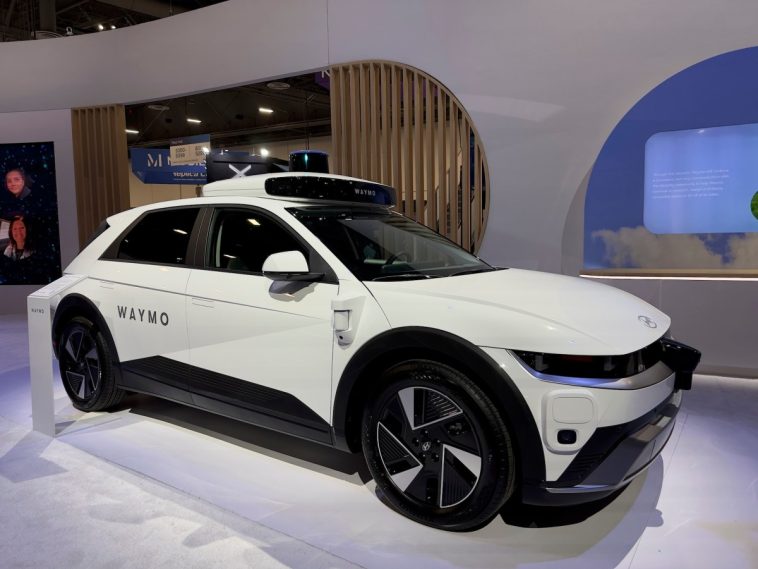Even before CES 2025 kicked off a few trends began to emerge — or more accurately, some gaps appeared.
All U.S. and some European automakers that have helped turn CES into an auto show were absent. Several Chinese automakers filled that void, notably Zeekr, the EV brand owned by China’s Geely Holdings. Wey, a premium brand under Great Wall Motor, and Xpeng also had booths.
The West Hall in the Las Vegas Convention Center, where the majority of vehicle and transportation tech sets up, felt emptier than previous years. And notably, some of the biggest announcements had nothing to do with new EVs — or other products that might take up a lot of physical space. Toyota, for instance, announced the first phase of Woven City, a prototype city built on 175 acres at the foot of Mount Fuji, was complete and in search of inventors and startups. Oh, and that it’s also “exploring rockets.” Not exactly something one can exhibit at CES.
Still, there was future-of-transportation tech to be discovered. This year, autonomous vehicle technology had a larger presence than ever before, and what was there provided a few hints how the rest of the year may shape up. Here are the major themes we spotted at the show.
AI and automated driving tech
Japanese company Tier IV displays at CES 2025 in Las Vegas. Image Credits:Kirsten Korosec
Some of the largest exhibits at the Las Vegas Convention Center focused on automated driving technologies.
Autonomous vehicle companies that are developing (or have launched) robotaxi services like May Mobility, Japanese company Tier IV, Waymo, and Zoox all had a presence. Notably, Zoox was also giving robotaxi rides to the media leading up to CES and throughout the show.
Automated tech popped in other places too, including agriculture-focused companies like John Deere and Kubota and startups like Polymath Robotics that apply its self-driving systems to off-road environments.
Perhaps the largest group of companies were showing off products that support automated driving and advanced driving assistance systems, including simulation, machine learning, sensors, and data integration. Even Honda got into the mix by announcing a new operating system called Asimo (yes, after the iconic robot) that will be integrated into its next-gen 0 Series EVs and used to support ADAS features.
Comma.ai was also on the scene. This startup, founded by George Hotz, has developed an open source driver-assistance system and supporting hardware that can be plugged into many modern vehicles to give it advanced driver assistance capabilities on par with Tesla Autopilot and GM’s hands-free Super Cruise system.
Vay, which has put a driverless twist on car-sharing, was also in Las Vegas — although not on the show floor. The startup, which set up shop in the city a couple of years ago, announced a major expansion of its service.
Nvidia continues to partner with everyone
Jensen Huang, co-founder and chief executive officer of Nvidia Corp., speaks during the Nvidia AI Summit Japan in Tokyo, Japan, on Wednesday, Nov. 13, 2024. SoftBank Group Corp. will be the first Nvidia customer to build a supercomputer based on the chipmaker’s new Blackwell design, a move to meet growing demand in a country eager to catch up in artificial intelligence. Photographer: Akio Kon/Bloomberg via Getty ImagesImage Credits:Akio Kon/Bloomberg / Getty Images
Every year at CES, the transportation desk gets a bundle of announcements from Nvidia detailing which automaker, supplier, and transportation partners have signed on to use Nvidia’s technology, and 2025 was no different. What stood out, though, was Nvidia’s commitment to providing as much of the self-driving stack as possible, from testing and simulation to onboard supercomputers to cloud supercomputing.
One prime example was Nvidia’s collaboration with Toyota. The two have worked together for years to help Toyota’s R&D unit develop, train, and validate AV technology, but this year, the two announced more concrete plans to have Nvidia’s tech power Toyota’s future vehicles, which we now know will be equipped with automated driving capabilities. Specifically, we’ll see Nvidia’s Drive AGX Orin System-on-a-Chip (SoC) and DriveOS safety-focused operating system deployed on Toyota’s next-generation vehicles.
When it comes to Level 4 autonomous vehicle technology (meaning, a system that can drive itself without needing a human to take over), Nvidia had more news to share. The chipmaker is partnering with self-driving trucking company Aurora Innovation and automotive supplier Continental that will see Nvidia’s Drive Thor SoC and DriveOS integrated into the Aurora Driver, which is Aurora’s AV system that Continental plans to mass produce in 2027.
Finally, one of the more surprising partnerships was with Uber. The ride-hail and delivery giant plans to use Nvidia’s new world model simulation tool, Cosmos, and cloud-based AI supercomputing platform, DGX Cloud, to support the development of autonomous vehicle technology. Uber didn’t share how it plans to use those tools, since it doesn’t develop its own AV tech. The company plans to partner with AV companies to bring self-driving services to its platform.
New takes on the screen
Valeo shows off its panovision technology at CES 2025. Image Credits:Kirsten Korosec
Screens are nothing new at CES. They have been everywhere for a while now. This year, there were some companies pushing the idea of screens beyond traditional ideas.
Supplier Valeo showed off a novel product that it calls panovision — and which will be in BMW’s next-generation Neue Klasse vehicles — that reflects a full screen along the base of the windshield. The company revealed this technology at CES 2024. This year, an in-cabin driver monitoring system has been integrated into the system.
Automotive supplier Hyundai Mobis showed off a holographic screen that covers the entire windshield. From the outside it looks like any other windshield. But from behind the driver’s seat the windshield turns into a transparent screen that gives information like navigation and music playlists.
GenAI is creeping into the car
Akio Toyoda, Chairman and Master Driver of Toyota, delivers an address at CES 2025, showcasing the company’s latest innovations in Las Vegas.Image Credits:Artur Widak/Anadolu via Getty Images / Getty Images
Automakers have been swept into the generative AI hype mix — a trend that started last year. Even the casual observer likely noticed the term “genAI” “chatgpt” or “LLMs” throughout the vehicle technology section of the LVCC.
It was everywhere — and nowhere, if you catch our drift. In some cases, there were real partnerships and plans behind the words.
Take BMW and its partnership with Amazon. BMW used CES 2025 to showcase its new in-car user interface, which will debut in its Neue Klasse sedan later this year and ultimately spreading to all models.
BMW said it will use Amazon’s Alexa custom assistant technology in these future vehicles as well as those on the road today. This isn’t the Alexa app drivers might be used to. This is a white label product that will integrate Amazon’s large language models. Use of this technology will focus initially on navigation, in an effort to let customers give more extensive spoken commands using natural language.
BMW and Amazon will start rolling out LLM-powered capabilities as part of a beta in select vehicles and countries.
Meanwhile, Qualcomm came to CES with improvements to its Snapdragon Digital Chassis (its suite of cloud-connected platforms for automakers) and Cockpit (its digital cockpit and infotainment system). And it wouldn’t be CES 2025 if some of those updates didn’t include generative AI.
The chipmaker said a range of automotive suppliers – like Alps Alpine, Panasonic, and Garmin – as well as Indian automaker Mahindra, plan to integrate Qualcomm technology into their experiences. Generative AI features now come with the territory for “intelligent and personalized in-cabin experiences.”
Some features that are powered by Meta’s Llama and OpenAI’s Whisper Small could look like real-time detection of distracted or drowsy driving; biometric identification to automatically adjust seat positions, mirror angles, etc.; navigation recommendations based on the driver’s state, like to a coffee shop if they look tired.
Other potential use cases for Qualcomm’s generative AI offerings could be multimodal AI that identifies points of interest en route, using models like Llama, open-source LlaVa, and Fast Stable Diffusion, or even custom content generation to deliver personalized, on-demand entertainment to passengers.
Micromobility exists!
Image Credits:Kirsten Korosec
Finally, there has been lots of talk — and evidence — that micromobility is dead. But that’s not quite right.
Sure, the shared scooter and ebike businesses have largely struggled, or shut down. But walking through the North Hall, we were struck by how many ebike and scooter brands (many of which were Chinese brands) were exhibiting.
Vmax released six new scooters for its 2025 lineup, Aima Technology Group revealed several new ebikes, and Heybikes released a mid-drive fat tire model. Segment leader Segwey also launched two new ebikes that are equipped with the company’s suite of smart tech and features called Intelligent Ride System.
Verge Motorcycles subsidiary Donut Lab also got into the mix and released an electric motor that can be integrated directly into the tire.





GIPHY App Key not set. Please check settings